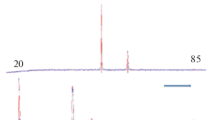Conclusions
-
1.
For stainless steels of the transition class the highest strength properties are obtained by multiple cold plastic deformation and subsequent aging.
-
2.
For unaged stainless steels of the austenitic — martensitic class there is no direct relationship between the amount of martensite and the strength characteristics.
Similar content being viewed by others
Literature cited
A. P. Gulyaev, Heat Treatment of Steel [in Russian], Mashgiz, Moscow (1960), pp. 161–162.
J. Bressanelli and A. Moskowitz, TASM,59, 223–239 (1966).
Yu. I. Kabanov et al., “Technology of thermomechanical strengthening of steel during rolling and pressing” Metal. i Term. Obrabotka Metal., 2, 55–58 (1964).
F. F. Khimushin, Stainless Steels [in Russian], Metallurgiya, Moscow (1967), p. 246.
Additional information
All-Union Scientific-Research Institute of the Bearing Industry. Translated from Metallovedenie i Termicheskaya Obrabotka Metallov, No. 12, pp. 31–33, December, 1974.
Rights and permissions
About this article
Cite this article
Burkin, V.S., Shein, A.S. & D'yakov, Y.I. Properties of stainless steels of the transition class after cold plastic deformation. Met Sci Heat Treat 16, 1031–1033 (1974). https://doi.org/10.1007/BF00664043
Issue Date:
DOI: https://doi.org/10.1007/BF00664043




